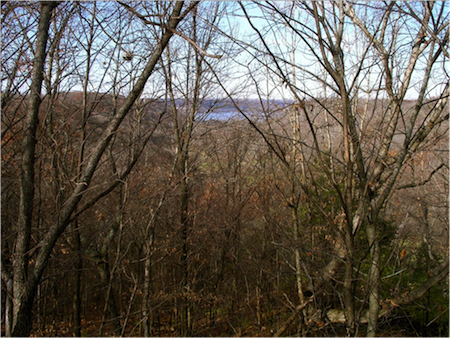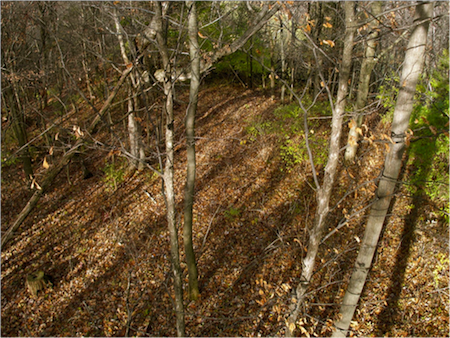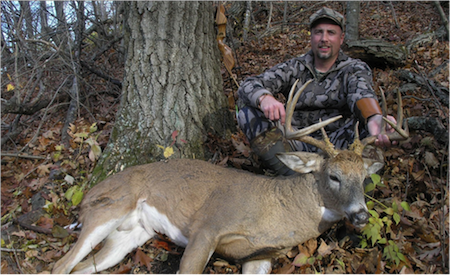 The rooster crowed, shattering the early morning silence. It was our alarm clock. My hunting partner, Mike Steliga, and I were hunting a 400 acre farm in southwestern Wisconsin. It was a classic farm with milk cows, calves, chickens, and even ducks. With only 75 acres of tillable land, the majority of the ground was timbered. In some spots it afforded aesthetic views of the Mississippi River. At 4:30 a.m. one goes through the process of groggily getting ready while trying not to make too much noise or forget anything of importance. My hunting partner had a different strategy in mind, and was safely snuggled in his sleeping bag. Our trailer was situated right on the farmyard, next to the duck pond and calf shed. When leaving the trailer, our nostrils were greeted with fresh farm aroma, and we had to walk somewhat carefully to avoid certain deposits that had been left behind.
The rooster crowed, shattering the early morning silence. It was our alarm clock. My hunting partner, Mike Steliga, and I were hunting a 400 acre farm in southwestern Wisconsin. It was a classic farm with milk cows, calves, chickens, and even ducks. With only 75 acres of tillable land, the majority of the ground was timbered. In some spots it afforded aesthetic views of the Mississippi River. At 4:30 a.m. one goes through the process of groggily getting ready while trying not to make too much noise or forget anything of importance. My hunting partner had a different strategy in mind, and was safely snuggled in his sleeping bag. Our trailer was situated right on the farmyard, next to the duck pond and calf shed. When leaving the trailer, our nostrils were greeted with fresh farm aroma, and we had to walk somewhat carefully to avoid certain deposits that had been left behind.
The walk to the stand in the pre-dawn darkness provided views of a starry sky. It was going to be a clear day. The big dipper was easily identifiable. As I hiked, it reminded me of all the work that had gone into getting ready for the hunt. Three springs of intensive scouting. Maps had been laminated with aerial views on one side and topographic maps on the other. Plenty of leg work had been accomplished in trying to determine deer movement, funnels etc. The farm we’re hunting was in bluff country. There is a fair amount of steep terrain. This sometimes narrows things down, yet complicates things with thermals and wind currents.
We called the stand I was headed to the Mississippi Overlook Stand. In previous years we had learned some lessons on wind and deer movement. The stand was nestled on the far north end of the property. On the north side was a steep drop-off. It had a fence line running alongside the stand in an east/west direction. On the west side of the stand the ground sloped down far below towards a valley called The Hollow. It had a standing corn field, which acted as a deer magnet. We discovered it was difficult to hunt low because of fickle winds. On each side of the stand were inside corners. Previous encounters resulted in picking a hickory tree that gave us the best spot to capitalize. Ten yards in front of the stand, to the west, the fence had been broken down by a fallen tree. It acted as an open gate, giving the deer access to both sides without jumping. To the northwest was a scrape near a cedar tree that appeared each year. This was the first morning of the week-long hunt. As I neared the stand, I tiptoed to the fence line and crept along it until reaching the stand.
As morning awakened, the squirrels became active. Appreciation was for the dogged determination of the red oak leaves that remained on this early November morning. Other wildlife came and went such as red cardinals, an eagle soaring, and a coyote sneaking through the area. Shortly thereafter a group of turkeys passed in front of the stand. At times like this, one cannot be still enough. I recalled seeing some nice bucks on previous hunts, and anticipation was running at high levels.

Sunrise this morning was 6:15 a.m. After the passing of time, one sometimes can get the feeling that maybe it’s not in the cards. Bowhunting has a way of mental ups and downs. As my mood turned a bit gloomy, I spotted a buck crossing below at approximately one hundred yards. It always amazes me how one can go from boredom to a burst of adrenaline in a matter of minutes when deer hunting. Realizing that he was going to cross over the ridge and go out of sight, I pulled a trick Barry Wensel had taught me some years ago at his one of his ‘Boot Camps’. Cupping my hands to my mouth I let loose- Pffft-Pffft- Pfffffff. The Wheeze. I’m sure a little spit dribble wound up on my coat front. Blame it on the cool morning. Not one, but two deer started working their way up the hill. I realized a doe was in the lead with the buck trailing. When I got a glimpse of his long tined rack my heart rate elevated.
I pride myself on staying calm and collected. However, on this morning I had to do a little talking to myself. I had the lower bow limb in a little pouch above my kneecap. My mother had sewn it on to keep my bow at the ready without having to move around much–another useful tip from Uncle Barry. The deer went over the top of the ridge approximately 30 yards away. I gave them some encouragement with a doe bleat. My intent was so focused on these two that I was surprised when a small 1 ½ year old passed right through the fence opening in front of me. The action was heating up. Just when I thought that they had moved on, I was surprised when they circled around and started back up the hill again toward the stand.
Suddenly, the doe bedded down. The buck’s head nodded and gave her some encouragement to get back on her feet. I realized she was in heat. The small buck was still hanging around. He showed himself over the crest of the hill. The long-tined buck put on quite a display of rubbing. I believe it was his way of intimidation. Without warning he charged and the smaller buck swapped ends and headed for parts unknown. Satisfied that he had run off the younger buck, he stopped in the scrape. This is the moment that all bowhunters dream about. Drawing back to my anchor the arrow took flight and, to my chagrin, flew low. I chided myself, saying something along the lines of, “You lousy…” The buck was so focused on the doe that it didn’t move, and wasn’t aware that I had shot in the soft and quiet leaves. I had another arrow on the string and, being more than a little agitated at myself, concentrated intently. The second arrow appeared to fly true to its mark, hitting behind the front shoulder. The buck went 25 yards before bedding down. His location was mostly obscured from view. I glanced at my watch–it was 10 a.m. I waited and watched. One hour went by and the buck staggered back up and bedded back down. I waited and watched some more. At straight up noon the buck rose again and faltered badly. I decided to carefully sneak out and go back to camp.
Encountering the farmer on the hike back, he asked if I had seen the big one, expecting the usual no for an answer. I said “Yep.”
“Did ya get him?”
“I think so!”
“Well, let’s go for some coffee!”
There are usually a million questions. My hunting buddy was shaking his head, muttering something about first mornings and lucky horseshoes. We all agreed that the buck behavior was quite strange and agreed that the best move was backing out rather than pressing the buck. In sneaking back, my hunting partner and the farmer hung back while I glassed the area. I would walk ten paces then glass again. Upon reaching the first area the buck had bedded down, I found no sign. Walking a few yards further I found the complete arrow with blood three quarters of the way up the shaft. The big ol’ Ben Pearson Deadhead was curled slightly at the tip. I had inherited this 40 year old broadhead from my father-in-law, who had passed on several years before. I decided that, for nostalgic reasons, I wanted to harvest a deer with it. I repainted it and was delighted that I could put a razor sharp edge on the old head. Several yards further a crimson trail, as if poured out of a paint can, led a short distance to the end of the trail. A little whistle and my partners joined me on the hillside. It was a time to absorb and appreciate the moment. We discussed the hunt and concluded that the arrow had acted as a plug until it had come out. The shot was perfect, tight behind the front shoulder. Field dressing revealed it had hit the offside shoulder. In addition, I had thought the shot was around twenty paces. In walking it off we arrived at 26 paces–deception of the downhill shot. Instinctive shooting plays to the subconscious and I was fortunate the buck did not bolt at the first shot. These times are ones relished and shared with good friends. The beauty of the hillside, sights of the river, and a fine buck are memories of a lifetime. My pals threatened to put ankle weights on my feet to keep me from floating off the ground.

The remaining part of the hunt is where hunting partners hang together. When one is successful, attention is turned to help the other realize his dreams. Activities turn to setting up and taking down treestands; scouting and covering ground for new areas for the following year. Even KP duties are taken over for dishwashing and cooking. In discussions during the evening, one can appreciate the effort in getting ready. It is realized that sometimes good fortune and luck play a role in any hunt. The maturity of a hunter is the acceptance of tags filled or unfilled, and that time afield and the company of good hunting companions is the real goal of any hunt.
The author used a Bruin recurve, GrizzlyStik carbon arrow and a Ben Pearson Deadhead broadhead.


Leave A Comment